Accelerated Urban Expansion in Lhasa City and the Implications for Sustainable Development in a Plateau City
Abstract
:1. Introduction
2. Materials and Methods
2.1. Study Area
2.2. Satellite Images
2.3. Determinants and Analysis Methods
3. Results
3.1. Land Cover Change of Lhasa (1990–2015)
3.2. The Changes of the Main Socio-Economic Indicators of Lhasa (1990–2015)
3.2.1. Economic Development
3.2.2. Urban Population Growth
3.2.3. Government Investment
3.2.4. Tourism Development
3.3. Determinants of Urban Expansion in Lhasa
3.4. Relative Importance of the Identified Determinants
4. Discussion
4.1. Determinants for Lhasa Expansion
4.2. Determinants of Urban Expansion in Different Regions in China
4.3. Suggestions and Implications
5. Conclusions
Acknowledgments
Author Contributions
Conflicts of Interest
Appendix A
| Data | Column/Row | Year | Spatial Resolution (m) |
|---|---|---|---|
| Spot1 | 5924/6000 | March 1990 | 10 |
| Spot4 | 5110/1768 | November 2001 | 10 |
| Spot5 | 18307/6258 | December 2008 | 2.5 |
| Word View | 94420/31076 | May 2015 | 0.5 |
Appendix B
| Qinghai | Gansu | Sichuan | Xinjiang | Ningxia | Chongqing | Guizhou | Inner Mongolia | Tibet | |
|---|---|---|---|---|---|---|---|---|---|
| State budget appropriation | 55.994 | 84.449 | 152.782 | 132.678 | 23.734 | 106.499 | 64.44 | 68.499 | 84.931 |
| Self-raised funds | 136.351 | 485.644 | 1688.449 | 610.044 | 162.486 | 835.35 | 570.403 | 941.733 | 38.12 |
| Domestic loans | 59.622 | 94.856 | 249.009 | 137.062 | 74.621 | 265.193 | 118.318 | 152.99 | 0.58 |
| Foreign investment | 0.422 | 3.448 | 9.507 | 0.325 | 0.285 | 28.269 | 2.776 | 1.02 | 0.14 |
| Bonds | 1.646 | 2.04 | 7.421 | 2.774 | 0 | 0.512 | 0 | 0 | 0 |
| Others | 28.532 | 77.054 | 442.192 | 96.514 | 37.764 | 315.732 | 239.596 | 68.637 | 6.36 |
| Total investment in fixed assets | 282.567 | 747.491 | 2549.36 | 979.397 | 298.89 | 1551.555 | 995.533 | 1232.879 | 130.131 |
| The proportion of state budget appropriation in investment in fixed assets | 19.82% | 11.3% | 5.99% | 13.55% | 7.94% | 6.86% | 6.47% | 5.56% | 65.27% |
Appendix C
| Districts | Number of Projects | Total (Billion RMB) | 2011 (Billion RMB) | 2012 (Billion RMB) | 2013 (Billion RMB) | 2014 (Billion RMB) | 2015 (Billion RMB) | Proportion |
|---|---|---|---|---|---|---|---|---|
| Lhasa | 165 | 3.08 | 0.52 | 0.56 | 0.63 | 0.68 | 0.68 | 21.82% |
| Lhoka Prefecture | 176 | 1.30 | 0.38 | 0.29 | 0.13 | 0.28 | 0.22 | 9.17% |
| Shigatse Prefecture | 575 | 3.26 | 0.57 | 0.64 | 0.60 | 0.72 | 0.74 | 23.10% |
| Nyingchi Prefecture | 361 | 2.66 | 0.51 | 0.52 | 0.44 | 0.57 | 0.62 | 18.80% |
| Chamdo Prefecture | 132 | 0.75 | 0.14 | 0.15 | 0.15 | 0.18 | 0.14 | 5.28% |
| Nagqu prefecture | 128 | 2.11 | 0.38 | 0.41 | 0.40 | 0.43 | 0.49 | 14.89% |
| Ngari Prefecture | 73 | 0.98 | 0.17 | 0.19 | 0.20 | 0.21 | 0.22 | 6.94% |
| Total | 1610 | 14.14 | 2.67 | 2.75 | 2.54 | 3.07 | 3.10 | 100% |
Appendix D
| Period | Regions | Determinants | Literatures | |
|---|---|---|---|---|
| China | 2005–2008 | China | Marketization, Globalization, Government | [49] |
| 1990–2010 | China | Immigration rural-urban, Fixed-asset investments, GDP growth, National regional strategies | [4] | |
| 1993–2012 | China | Economic growth, Industrial development, Economic structural transformation | [5] | |
| China | - | China | Institutional, cultural conditions, Economy and industry conditions | [65] |
| China | - | China | Globalization, Government | [63] |
| Eastern China | 2000–2010 | Eastern China | Service exports, International trade | [21] |
| Central China | Central China | Service exports, International trade, Foreign direct investment | ||
| Northeastern | Northeastern | Service exports, International trade | ||
| Eastern China | 1990–2010 | Eastern China | Population growth, Road construction | [31] |
| Middle China | Middle China | Secondary industry, Economic development | ||
| Western China | Western China | Economic growth | ||
| Provincial level | 1992–2009 | Provincial level | Economic factors | [24] |
| Prefectural level | Prefectural level | Economic, Demographic, and traffic factors | ||
| County level | County level | Demographic factors | ||
| Beijing | 1972–2010 | Beijing | Physical, Socioeconomic, Neighborhood factors | [61] |
| Xiamen Island | 1908–2007 | Xiamen Island | Natural and socio-economic factors | [55] |
| The pearl river delta | 1979–2002 | Guangzhou | GDP, Total population, Urban resident income, Urban traffic | [69] |
| 1990–2008 | Shenzhen | Technology, Government policy, Geographical factor, GDP | [52] | |
| The Yangtze river delta | 1985–2013 | Nanjing | Non-agricultural population, Foreign direct investment, Tertiary sector | [3] |
| 1995–2013 | Nanjing | Infrastructure, Commercial, Industrial sub-centers, Government policies | [77] | |
| 1985–2006 | Shanghai | Industrial structure improvement, Government policy | [70] | |
| Central China | 1986–2013 | Shuozhou City | Non-agricultural population, Coalindustry | [42] |
| 1980–2010 | Wuhan | Industrialization, Urban population growth, Government policies | [78] | |
| 1949–2004 | Changsha | Population, Economic, Transportation infrastructure, Strategic instruction | [67] |
References
- Angel, S.; Parent, J.; Civco, D.L.; Blei, A.; Potere, D. The dimensions of global urban expansion: Estimates and projections for all countries, 2000–2050. Prog. Plan. 2011, 75, 53–107. [Google Scholar] [CrossRef]
- Seto, K.C.; Fragkias, M.; Guneralp, B.; Reilly, M.K. A Meta-Analysis of Global Urban Land Expansion. PLoS ONE 2011, 6, e23777. [Google Scholar] [CrossRef] [PubMed]
- Chen, J.L.; Gao, J.L.; Chen, W. Urban land expansion and the transitional mechanisms in Nanjing, China. Habitat Int. 2016, 53, 274–283. [Google Scholar] [CrossRef]
- Kuang, W.H.; Liu, J.Y.; Dong, J.W.; Chi, W.F.; Zhang, C. The rapid and massive urban and industrial land expansions in China between 1990 and 2010: A CLUD-based analysis of their trajectories, patterns, and drivers. Landsc. Urban Plan. 2016, 145, 21–33. [Google Scholar] [CrossRef]
- Zhang, Q.W.; Su, S.L. Determinants of urban expansion and their relative importance: A comparative analysis of 30 major metropolitans in China. Habitat Int. 2016, 58, 89–107. [Google Scholar] [CrossRef]
- Sakata, Y.; Yamasaki, M.; Ohgushi, T. Urban landscape and forest vegetation regulate the range expansion of an exotic lace bug Corythucha marmorata (Hemiptera: Tingidae). Entomol. Sci. 2016, 19, 315–318. [Google Scholar] [CrossRef]
- He, C.Y.; Liu, Z.F.; Tian, J.; Ma, Q. Urban expansion dynamics and natural habitat loss in China: A multiscale landscape perspective. Glob. Chang. Biol. 2014, 20, 2886–2902. [Google Scholar] [CrossRef] [PubMed]
- Lin, T.; Xue, X.Z.; Shi, L.Y.; Gao, L.J. Urban spatial expansion and its impacts on island ecosystem services and landscape pattern: A case study of the island city of Xiamen, Southeast China. Ocean Coast. Manag. 2013, 81, 90–96. [Google Scholar] [CrossRef]
- Batisani, N.; Yarnal, B. Urban expansion in Centre County, Pennsylvania: Spatial dynamics and landscape transformations. Appl. Geogr. 2009, 29, 235–249. [Google Scholar] [CrossRef]
- Agegnehu, S.K.; Fuchs, H.; Navratil, G.; Stokowski, P.; Vuolo, F.; Mansberger, R. Spatial Urban Expansion and Land Tenure Security in Ethiopia: Case Studies from Bahir Dar and Debre Markos Peri-Urban Areas. Soc. Nat. Resour. 2016, 29, 311–328. [Google Scholar] [CrossRef]
- Valerio, Q.; Anna, B.; Francesco, C.; Diego, G.; Dalila, R.; Piermaria, C. Monitoring land take by point sampling: Pace and dynamics of urban expansion in the Metropolitan City of Rome. Landsc. Urban Plan. 2015, 143, 126–133. [Google Scholar] [CrossRef]
- Barragan, J.M.; de Andres, M. Urban expansion in the coastal areas of Latin America and Caribbean. Rev. Geogr. Norte Gd. 2016, 64, 129–149. [Google Scholar]
- Leyva-Camacho, O.; Venegas-Cardoso, R.; Rojas-Caldelas, R.; Ranfla-Gonzalez, A.; Pena-Salmon, C. Urban expansion and change of land uses: City of Mexicali 1990–2005. Wit Trans. Ecol. Environ. 2010, 129, 547–558. [Google Scholar]
- Kantakumar, L.N.; Kumar, S.; Schneider, K. Spatiotemporal urban expansion in Pune metropolis, India using remote sensing. Habitat Int. 2016, 51, 11–22. [Google Scholar] [CrossRef]
- Gibson, J.; Boe-Gibson, G.; Stichbury, G. Urban land expansion in India 1992–2012. Food Policy 2015, 56, 100–113. [Google Scholar] [CrossRef]
- Kumar, A.; Pandey, A.C.; Hoda, N.; Jeyaseelan, A.T. Evaluating the Long-term Urban Expansion of Ranchi Urban Agglomeration, India Using Geospatial Technology. J. Indian Soc. Remote Sens. 2011, 39, 213–224. [Google Scholar] [CrossRef]
- Paulsen, K. Yet even more evidence on the spatial size of cities: Urban spatial expansion in the US, 1980–2000. Reg. Sci. Urban Econ. 2012, 42, 561–568. [Google Scholar] [CrossRef]
- Tsutsumida, N.; Saizen, I.; Matsuoka, M.; Ishii, R. Addressing urban expansion using feature-oriented spatial data in a peripheral area of Ulaanbaatar, Mongolia. Habitat Int. 2015, 47, 196–204. [Google Scholar] [CrossRef] [Green Version]
- Mansaray, L.R.; Huang, J.F.; Kamara, A.A. Mapping deforestation and urban expansion in Freetown, Sierra Leone, from pre- to post-war economic recovery. Environ. Monit. Assess. 2016, 188, 470. [Google Scholar] [CrossRef] [PubMed]
- Zhang, Z.X.; Wen, Q.K.; Liu, F.; Zhao, X.L.; Liu, B.; Xu, J.Y.; Yi, L.; Hu, S.G.; Wang, X.; Zuo, L.J.; et al. Urban expansion in China and its effect on cultivated land before and after initiating “Reform and Open Policy”. Sci. China Earth Sci. 2016, 59, 1930–1945. [Google Scholar] [CrossRef]
- Shi, Y.; Yang, J.Y.; Hu, X.Y. How economic globalization affects urban expansion: An empirical analysis of 30 Chinese provinces for 2000–2010. Qual. Quant. 2016, 50, 1117–1133. [Google Scholar] [CrossRef]
- Huang, X.M.; Schneider, A.; Friedl, M.A. Mapping sub-pixel urban expansion in China using MODIS and DMSP/OLS nighttime lights. Remote Sens. Environ. 2016, 175, 92–108. [Google Scholar] [CrossRef]
- Wen, Q.K.; Zhang, Z.X.; Shi, L.F.; Zhao, X.L.; Liu, F.; Xu, J.Y.; Yi, L.; Liu, B.; Wang, X.; Zuo, L.J.; et al. Extraction of basic trends of urban expansion in China over past 40 years from satellite images. Chin. Geogr. Sci. 2016, 26, 129–142. [Google Scholar] [CrossRef]
- Ma, Q.; He, C.Y.; Wu, J.G. Behind the rapid expansion of urban impervious surfaces in China: Major influencing factors revealed by a hierarchical multiscale analysis. Land Use Policy 2016, 59, 434–445. [Google Scholar] [CrossRef]
- Liu, F.; Zhang, Z.X.; Wang, X. Forms of Urban Expansion of Chinese Municipalities and Provincial Capitals, 1970s-2013. Remote Sens. 2016, 8, 930. [Google Scholar] [CrossRef]
- Liu, F.; Zhang, Z.X.; Shi, L.F.; Zhao, X.L.; Xu, J.Y.; Yi, L.; Liu, B.; Wen, Q.K.; Hu, S.G.; Wang, X.; et al. Urban expansion in China and its spatial-temporal differences over the past four decades. J. Geogr. Sci. 2016, 26, 1477–1496. [Google Scholar] [CrossRef]
- Zhao, S.Q.; Zhou, D.C.; Zhu, C.; Sun, Y.; Wu, W.J.; Liu, S.G. Spatial and Temporal Dimensions of Urban Expansion in China. Environ. Sci. Technol. 2015, 49, 9600–9609. [Google Scholar] [CrossRef] [PubMed]
- Zhao, S.Q.; Zhou, D.C.; Zhu, C.; Qu, W.Y.; Zhao, J.J.; Sun, Y.; Huang, D.; Wu, W.J.; Liu, S.G. Rates and patterns of urban expansion in China’s 32 major cities over the past three decades. Landsc. Ecol. 2015, 30, 1541–1559. [Google Scholar] [CrossRef]
- Gibson, J.; Li, C.; Boe-Gibson, G. Economic Growth and Expansion of China’s Urban Land Area: Evidence from Administrative Data and Night Lights, 1993–2012. Sustainability 2014, 6, 7850–7865. [Google Scholar] [CrossRef]
- Liu, J.Y.; Zhang, Q.; Hu, Y.F. Regional differences of China’s urban expansion from late 20th to early 21st century based on remote sensing information. Chin. Geogr. Sci. 2012, 22, 1–14. [Google Scholar] [CrossRef]
- Tian, G.J.; Xu, X.L.; Liu, X.J.; Kong, L.Q. The Comparison and Modeling of the Driving Factors of Urban Expansion for Thirty-Five Big Cities in the Three Regions in China. Adv. Meteorol. 2016, 2016. [Google Scholar] [CrossRef]
- Wu, W.J.; Zhao, S.Q.; Zhu, C.; Jiang, J.L. A comparative study of urban expansion in Beijing, Tianjin and Shijiazhuang over the past three decades. Landsc. Urban Plan. 2015, 134, 93–106. [Google Scholar] [CrossRef]
- Zhao, P.J. Sustainable urban expansion and transportation in a growing megacity: Consequences of urban sprawl for mobility on the urban fringe of Beijing. Habitat Int. 2010, 34, 236–243. [Google Scholar] [CrossRef]
- Wu, Y.Y.; Li, S.Y.; Yu, S.X. Monitoring urban expansion and its effects on land use and land cover changes in Guangzhou city, China. Environ. Monit. Assess. 2016, 188, 54. [Google Scholar] [CrossRef] [PubMed]
- Chen, J.L.; Gao, J.L.; Yuan, F. Growth Type and Functional Trajectories: An Empirical Study of Urban Expansion in Nanjing, China. PLoS ONE 2016, 11, e0148389. [Google Scholar] [CrossRef] [PubMed]
- Li, H.; Wei, Y.H.D.; Huang, Z.J. Urban Land Expansion and Spatial Dynamics in Globalizing Shanghai. Sustainability 2014, 6, 8856–8875. [Google Scholar] [CrossRef]
- Yin, J.; Yin, Z.E.; Zhong, H.D.; Xu, S.Y.; Hu, X.M.; Wang, J.; Wu, J.P. Monitoring urban expansion and land use/land cover changes of Shanghai metropolitan area during the transitional economy (1979–2009) in China. Environ. Monit. Assess. 2011, 177, 609–621. [Google Scholar] [CrossRef] [PubMed]
- Tian, G.J.; Ma, B.R.; Xu, X.L.; Liu, X.P.; Xu, L.Y.; Liu, X.J.; Xiao, L.; Kong, L.Q. Simulation of urban expansion and encroachment using cellular automata and multi-agent system model-A case study of Tianjin metropolitan region, China. Ecol. Indic. 2016, 70, 439–450. [Google Scholar] [CrossRef]
- Ma, X.Y.; Zhang, Y.C. Numerical study of the impacts of urban expansion on Meiyu precipitation over Eastern China. J. Meteorol. Res. 2015, 29, 237–256. [Google Scholar] [CrossRef]
- Sun, Y.; Zhao, S.Q.; Qu, W.Y. Quantifying spatiotemporal patterns of urban expansion in three capital cities in Northeast China over the past three decades using satellite data sets. Environ. Earth Sci. 2015, 73, 7221–7235. [Google Scholar] [CrossRef]
- Zeng, C.; Zhang, M.D.; Cui, J.X.; He, S.W. Monitoring and modeling urban expansion—A spatially explicit and multi-scale perspective. Cities 2015, 43, 92–103. [Google Scholar] [CrossRef]
- Cao, Y.G.; Bai, Z.K.; Zhou, W.; Zhang, X.R. Analyses of traits and driving forces on urban land expansion in a typical coal-resource-based city in a loess area. Environ. Earth Sci. 2016, 75, 1191. [Google Scholar] [CrossRef]
- Zhang, X.; Bai, Z.; Fan, X.; Lu, Y.; Cao, Y.; Zhao, Z.; Sun, Q.; Pan, J. Urban Expansion Process, Pattern, and Land Use Response in an Urban Mining Composited Zone from 1986 to 2013. J. Urban Plan. Dev. 2016, 142, 04016014. [Google Scholar] [CrossRef]
- Jiang, L.; Zhang, Y.H. Modeling Urban Expansion and Agricultural Land Conversion in Henan Province, China: An Integration of Land Use and Socioeconomic Data. Sustainability 2016, 8, 920. [Google Scholar] [CrossRef]
- Peng, W.F.; Wang, G.J.; Zhou, J.M.; Zhao, J.F.; Yang, C.J. Studies on the temporal and spatial variations of urban expansion in Chengdu, western China, from 1978 to 2010. Sustain. Cities Soc. 2015, 17, 141–150. [Google Scholar] [CrossRef]
- Liu, Y.X.; Zhang, X.L.; Lei, J.; Zhu, L. Urban expansion of oasis cities between 1990 and 2007 in Xinjiang, China. Int. J. Sustain. Dev. World. Ecol. 2010, 17, 253–262. [Google Scholar] [CrossRef]
- Cao, Y.G.; Bai, Z.K.; Zhou, W.; Ai, G. Gradient Analysis of Urban Construction Land Expansion in the Chongqing Urban Area of China. J. Urban Plan. Dev. 2015, 141. [Google Scholar] [CrossRef]
- Shu, B.R.; Zhang, H.H.; Li, Y.L.; Qu, Y.; Chen, L.H. Spatiotemporal variation analysis of driving forces of urban land spatial expansion using logistic regression: A case study of port towns in Taicang City, China. Habitat Int. 2014, 43, 181–190. [Google Scholar] [CrossRef]
- Deng, X.Z.; Huang, J.K.; Rozelle, S.; Uchida, E. Growth, population and industrialization, and urban land expansion of China. J. Urban Econ. 2008, 63, 96–115. [Google Scholar] [CrossRef]
- Fahmi, F.Z.; Hudalah, D.; Rahayu, P.; Woltjer, J. Extended urbanization in small and medium-sized cities: The case of Cirebon, Indonesia. Habitat Int. 2014, 42, 1–10. [Google Scholar] [CrossRef]
- Huang, Z.J.; Wei, Y.D.; He, C.F.; Li, H. Urban land expansion under economic transition in China: A multilevel modeling analysis. Habitat Int. 2015, 47, 69–82. [Google Scholar] [CrossRef]
- Chen, J.F.; Chang, K.T.; Karacsonyi, D.; Zhang, X.L. Comparing urban land expansion and its driving factors in Shenzhen and Dongguan, China. Habitat Int. 2014, 43, 61–71. [Google Scholar] [CrossRef]
- Quan, B.; Bai, Y.J.; Romkens, M.J.M.; Chang, K.T.; Song, H.; Guo, T.; Lei, S. Urban land expansion in Quanzhou City, China, 1995–2010. Habitat Int. 2015, 48, 131–139. [Google Scholar] [CrossRef]
- Li, Y.; Ye, J.H.; Chen, X.H.; Abdel-Aty, P.E.M.A.; Cen, M. Transportation Characteristics Change under Rapid Urban Expansion: A Case Study of Shanghai. Chin. Geogr. Sci. 2010, 20, 554–561. [Google Scholar] [CrossRef]
- Li, X.H.; Lin, T.; Zhang, G.Q.; Xiao, L.S.; Zhao, Q.J.; Cui, S.H. Dynamic analysis of urban spatial expansion and its determinants in Xiamen Island. J. Geogr. Sci. 2011, 21, 503–520. [Google Scholar] [CrossRef]
- Long, H.; Wu, X.; Wang, W.; Dong, G. Analysis of Urban-Rural Land-Use Change during 1995–2006 and Its Policy Dimensional Driving Forces in Chongqing, China. Sensors 2008, 8, 681–699. [Google Scholar] [CrossRef] [PubMed]
- Vannier, C.; Jérémie, L.; Pierre-Yves, L.; Sandra, L. Patterns of landscape change in a rapidly urbanizing mountain region. Cybergeo 2016. [Google Scholar] [CrossRef]
- Haller, A. Vivid valleys, pallid peaks? Hypsometric variations and rural-urban land change in the Central Peruvian Andes. Appl. Geogr. 2012, 35, 439–447. [Google Scholar] [CrossRef] [PubMed]
- Walcott, S.M. Thimphu. Cities 2009, 26, 158–170. [Google Scholar] [CrossRef]
- Cai, Y.B.; Zhang, H.; Pan, W.B.; Chen, Y.H.; Wang, X.R. Urban expansion and its influencing factors in Natural Wetland Distribution Area in Fuzhou City, China. Chin. Geogr. Sci. 2012, 22, 568–577. [Google Scholar] [CrossRef]
- Li, Z.; Gu, X.; Wang, L.; Li, D.; Xie, Y.; Li, K.; Dubovik, O.; Schuster, G.; Goloub, P.; Zhang, Y.; et al. Aerosol physical and chemical properties retrieved from ground-based remote sensing measurements during heavy haze days in Beijing winter. Atmos. Chem. Phys. 2013, 13, 10171–10183. [Google Scholar] [CrossRef] [Green Version]
- Qian, J.; Peng, Y.F.; Luo, C.; Wu, C.; Du, Q.Y. Urban Land Expansion and Sustainable Land Use Policy in Shenzhen: A Case Study of China’s Rapid Urbanization. Sustainability 2016, 8, 16. [Google Scholar] [CrossRef]
- Lu, D.; Tian, Y.; Liu, V.; Zhang, Y. The Performance of the Smart Cities in China—A Comparative Study by Means of Self-Organizing Maps and Social Networks Analysis. Sustainability 2015, 7, 7604–7621. [Google Scholar] [CrossRef]
- Zhou, R.; Zhang, H.; Ye, X.-Y.; Wang, X.-J.; Su, H.-L. The Delimitation of Urban Growth Boundaries Using the CLUE-S Land-Use Change Model: Study on Xinzhuang Town, Changshu City, China. Sustainability 2016, 8, 1182. [Google Scholar] [CrossRef]
- Pang, B.; Fang, C.; Liu, H. Quantitative Study on the Dynamic Mechanism of Smart Low-Carbon City Development in China. Sustainability 2016, 8, 507. [Google Scholar] [CrossRef]
- Sun, J.; Wang, X.; Cheng, G.; Wu, J.; Hong, J.; Niu, S. Effects of grazing regimes on plant traits and soil nutrients in an alpine steppe, Northern Tibetan Plateau. PLoS ONE 2014, 9, e108821. [Google Scholar] [CrossRef] [PubMed]
- Li, C.; Zhao, J.; Xu, Y. Examining spatiotemporally varying effects of urban expansion and the underlying driving factors. Sustain. Cities Soc. 2017, 28, 307–320. [Google Scholar] [CrossRef]
- Choudhary, K.; Boori, M.S.; Kupriyanov, A.; Kovelskiy, V. Analysis of urban spatio-temporal land use/cover change and expansion with their driving force through remote sensing and GIS in Samara city, Russia. Adv. Mater. Mech. Struct. Eng. 2016. [Google Scholar] [CrossRef]
- Ma, Y.L.; Xu, R.S. Remote sensing monitoring and driving force analysis of urban expansion in Guangzhou City, China. Habitat Int. 2010, 34, 228–235. [Google Scholar] [CrossRef]
- Shi, L.Y.; Shao, G.F.; Cui, S.H.; Li, X.Q.; Lin, T.; Yin, K.; Zhao, J.Z. Urban three-dimensional expansion and its driving forces—A case study of Shanghai, China. Chin. Geogr. Sci. 2009, 19, 291–298. [Google Scholar] [CrossRef]
- Almadani, S.; Ibrahim, E.; Abdelrahman, K.; Al-Bassam, A.; Al-Shmrani, A. Magnetic and seismic refraction survey for site investigation of an urban expansion site in Abha District, Southwest Saudi Arabia. Arab. J. Geosci. 2015, 8, 2299–2312. [Google Scholar] [CrossRef]
- Webster, R.D.J. Haze Measurement. J. Inst. Brew. 1983, 89, 143. [Google Scholar]
- Chen, Y.-L.; Ding, J.-Z.; Peng, Y.-F.; Li, F.; Yang, G.-B.; Liu, L.; Qin, S.-Q.; Fang, K.; Yang, Y.-H. Patterns and drivers of soil microbial communities in Tibetan alpine and global terrestrial ecosystems. J. Biogeogr. 2016, 43, 2027–2039. [Google Scholar] [CrossRef]
- Gao, J.L.; Wei, Y.D.; Chen, W.; Yenneti, K. Urban Land Expansion and Structural Change in the Yangtze River Delta, China. Sustainability 2015, 7, 10281–10307. [Google Scholar] [CrossRef]
- Pinna, F.; Masala, F.; Garau, C. Urban Policies and Mobility Trends in Italian Smart Cities. Sustainability 2017, 9, 494. [Google Scholar] [CrossRef]
- Anttiroiko, A.V. Urban Planning 2.0. Int. J. E Plan. Res. 2012, 1, 16–30. [Google Scholar] [CrossRef]
- Chen, J.L.; Gao, J.L.; Yuan, F.; Wei, Y.D. Spatial Determinants of Urban Land Expansion in Globalizing Nanjing, China. Sustainability 2016, 8, 868. [Google Scholar] [CrossRef]
- Lu, S.S.; Guan, X.L.; He, C.; Zhang, J.L. Spatio-Temporal Patterns and Policy Implications of Urban Land Expansion in Metropolitan Areas: A Case Study of Wuhan Urban Agglomeration, Central China. Sustainability 2014, 6, 4723–4748. [Google Scholar] [CrossRef]
- Zhou, G.H.; He, Y.H. The influencing factors of urban land expansion in Changsha. J. Geogr. Sci. 2007, 17, 487–499. [Google Scholar] [CrossRef]
- Xiao, J.; Shen, Y.; Ge, J.; Tateishi, R.; Tang, C.; Liang, Y.; Huang, Z. Evaluating urban expansion and land use change in Shijiazhuang, China, by using GIS and remote sensing. Landsc. Urban Plan. 2006, 75, 69–80. [Google Scholar] [CrossRef]
- Li, T. Land use dynamics driven by rural industrialization and land finance in the peri-urban areas of China: “The examples of Jiangyin and Shunde”. Land Use Policy 2015, 45, 117–127. [Google Scholar]
- Gao, J.L.; Wei, Y.D.; Chen, W.; Chen, J.L. Economic transition and urban land expansion in Provincial China. Habitat Int. 2014, 44, 461–473. [Google Scholar] [CrossRef]
- Feng, J.; Lichtenberg, E.; Ding, C.R. Balancing act: Economic incentives, administrative restrictions, and urban land expansion in China. China Econ. Rev. 2015, 36, 184–197. [Google Scholar] [CrossRef]
- Li, H.; Wei, Y.D.; Liao, F.H.; Huang, Z.J. Administrative hierarchy and urban land expansion in transitional China. Appl. Geogr. 2015, 56, 177–186. [Google Scholar] [CrossRef]
- Balasubramaniam, A.; Paul, A.; Hong, W.-H.; Seo, H.; Kim, J. Comparative Analysis of Intelligent Transportation Systems for Sustainable Environment in Smart Cities. Sustainability 2017, 9, 1120. [Google Scholar] [CrossRef]

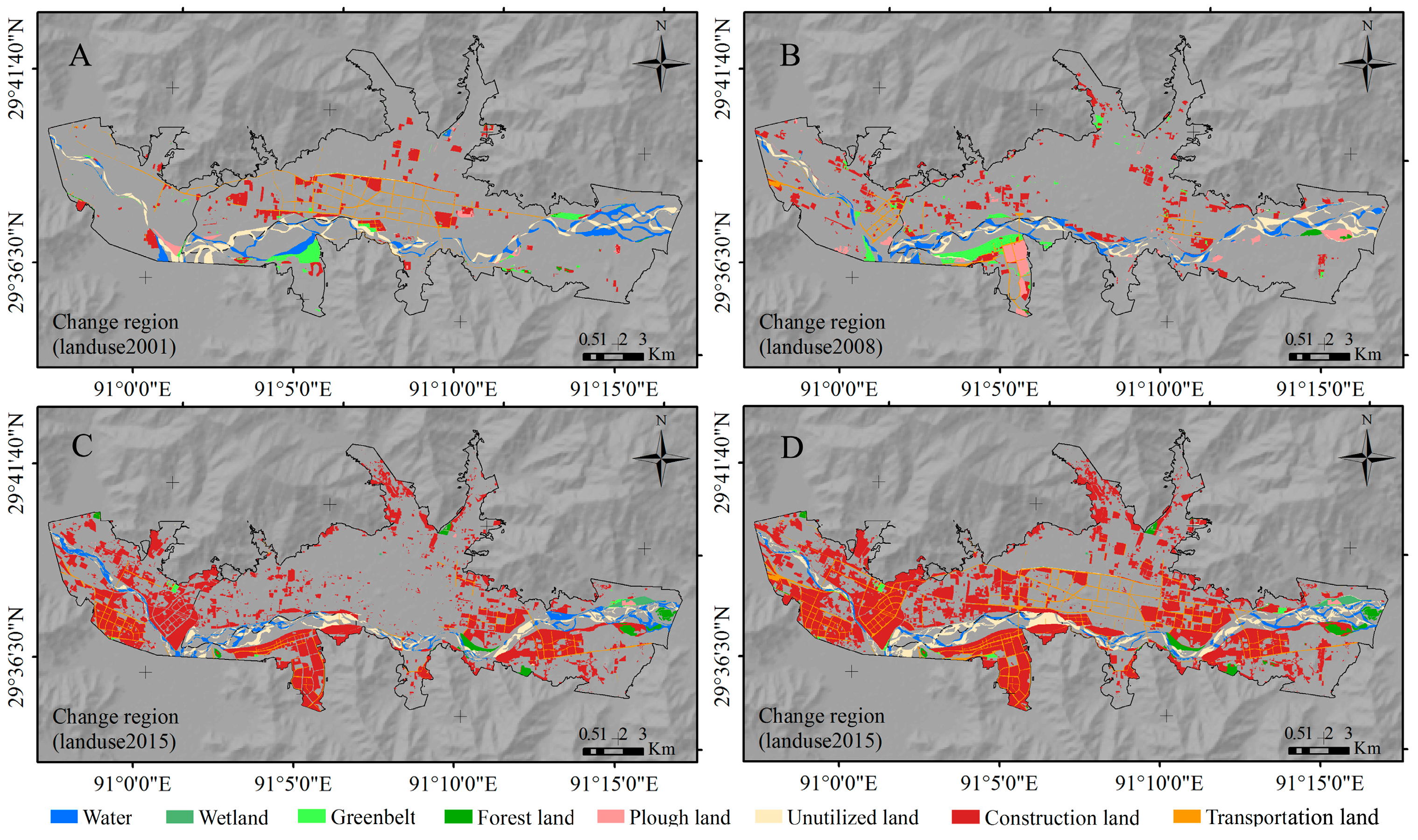
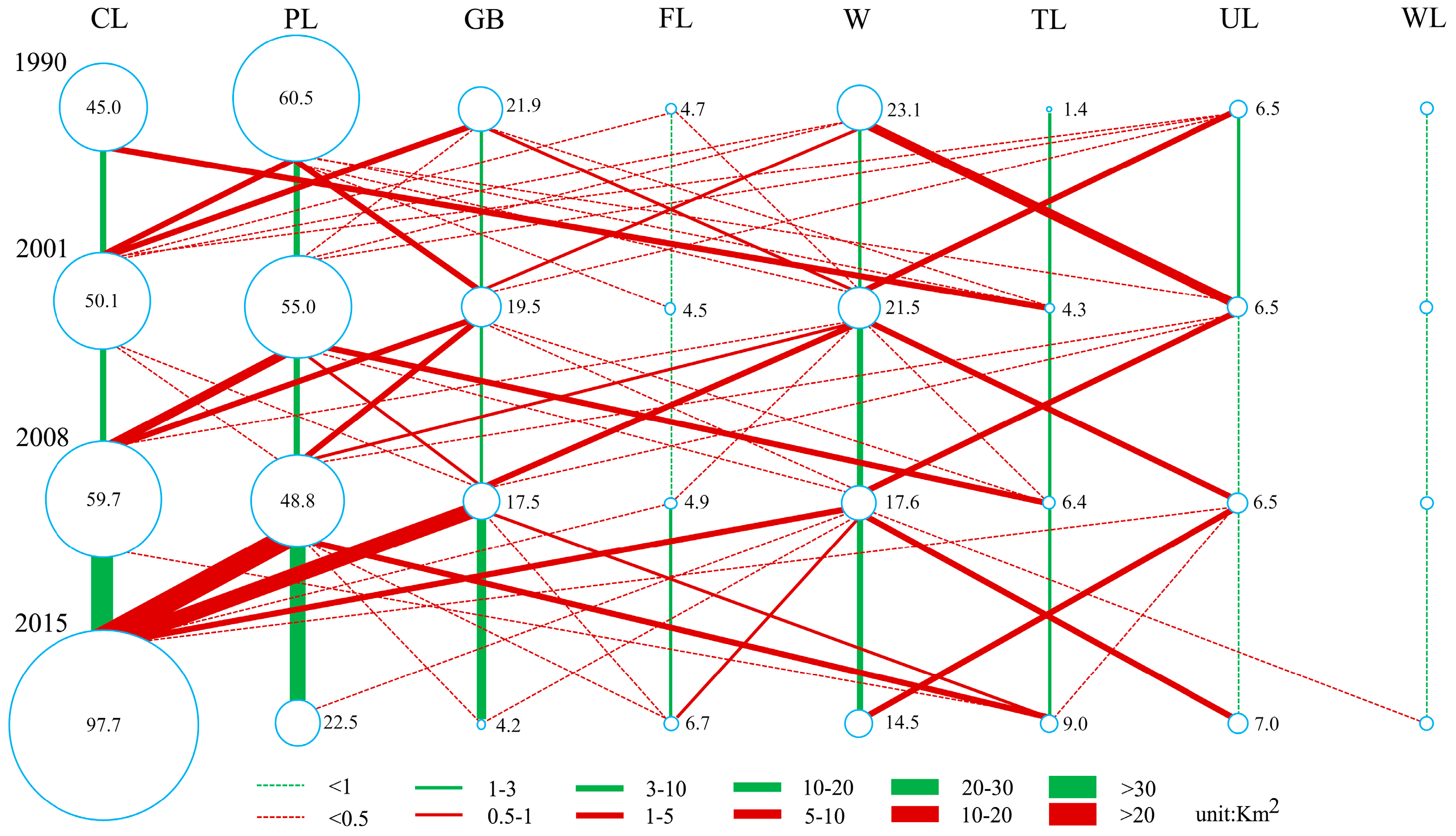
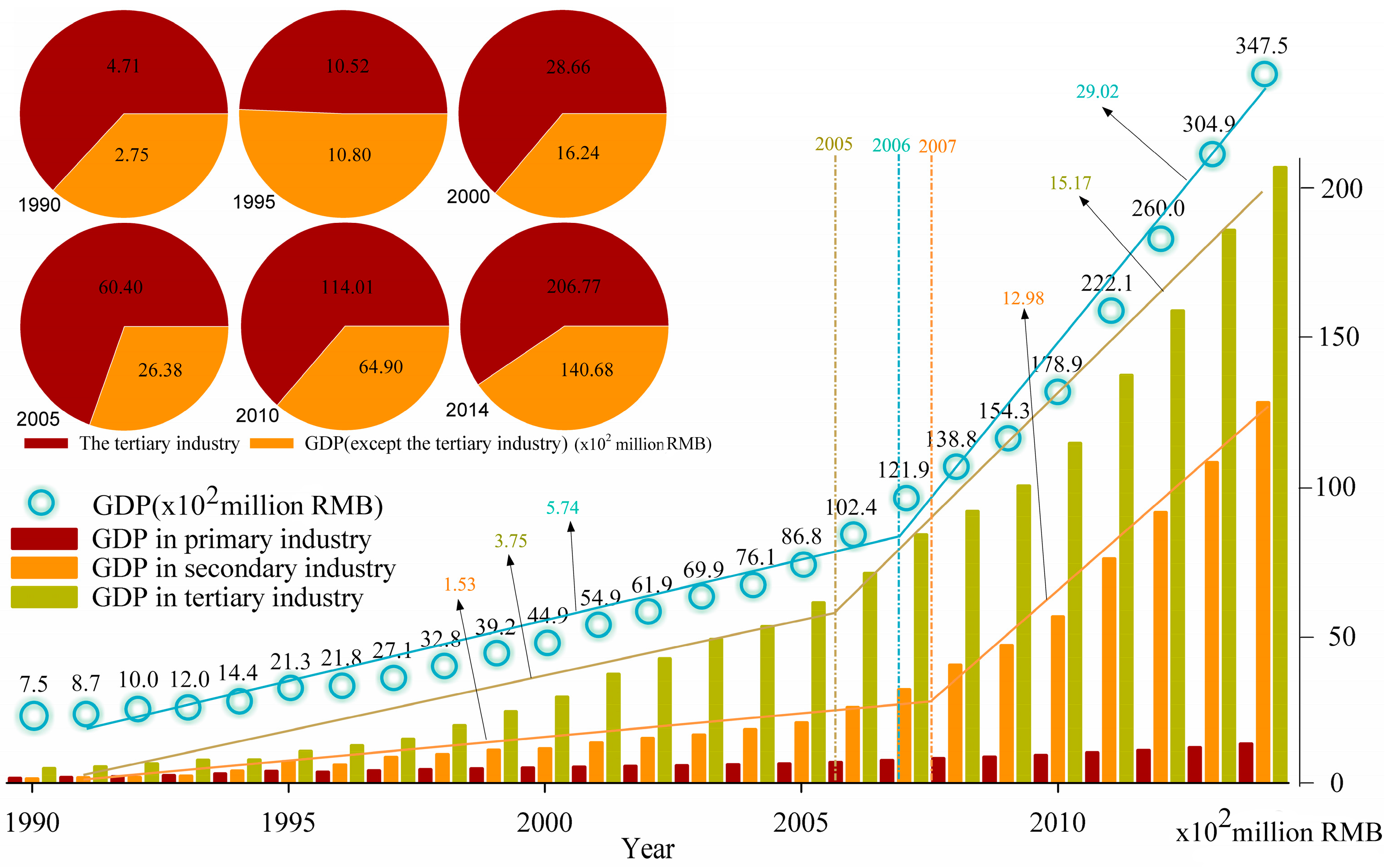

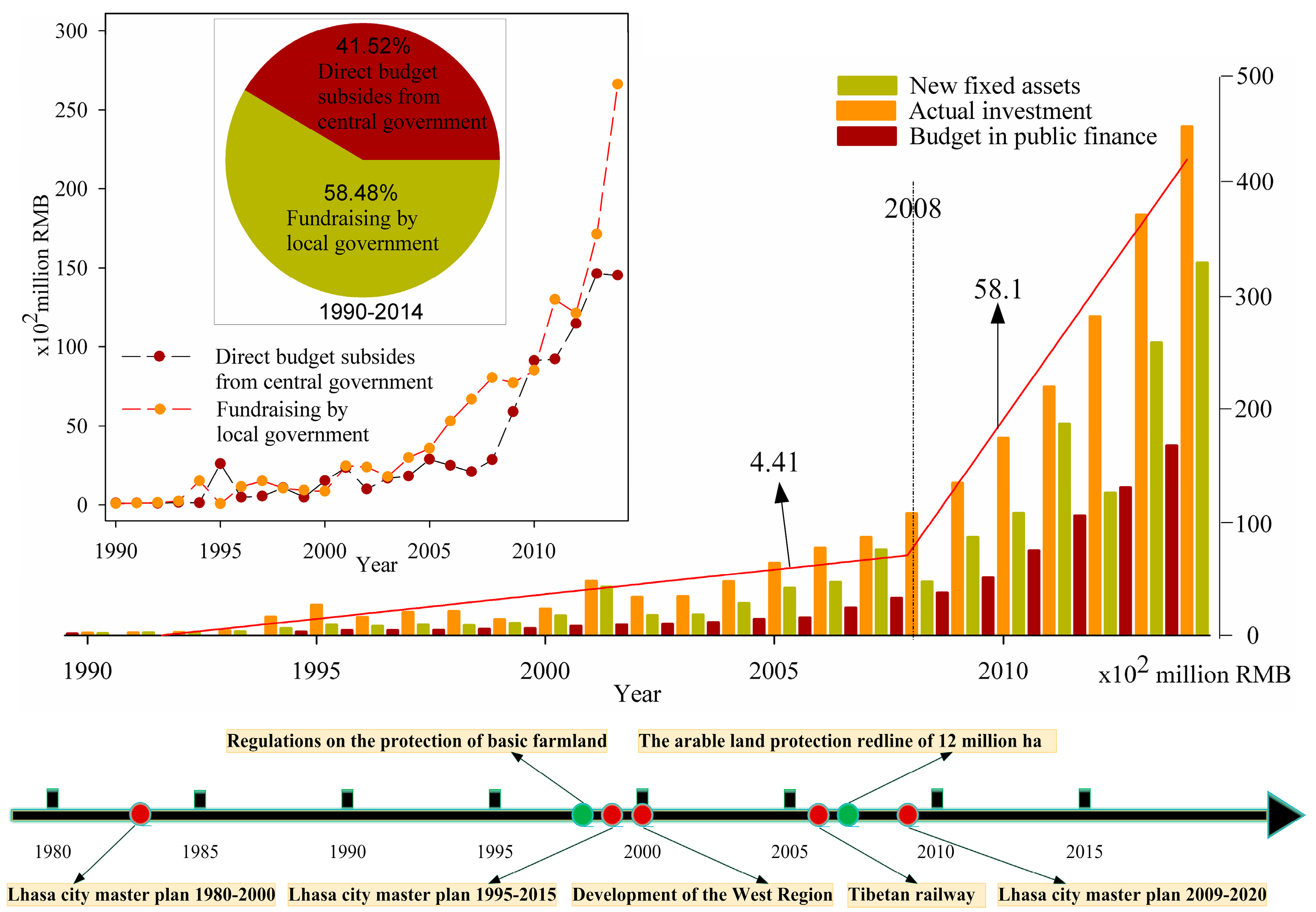
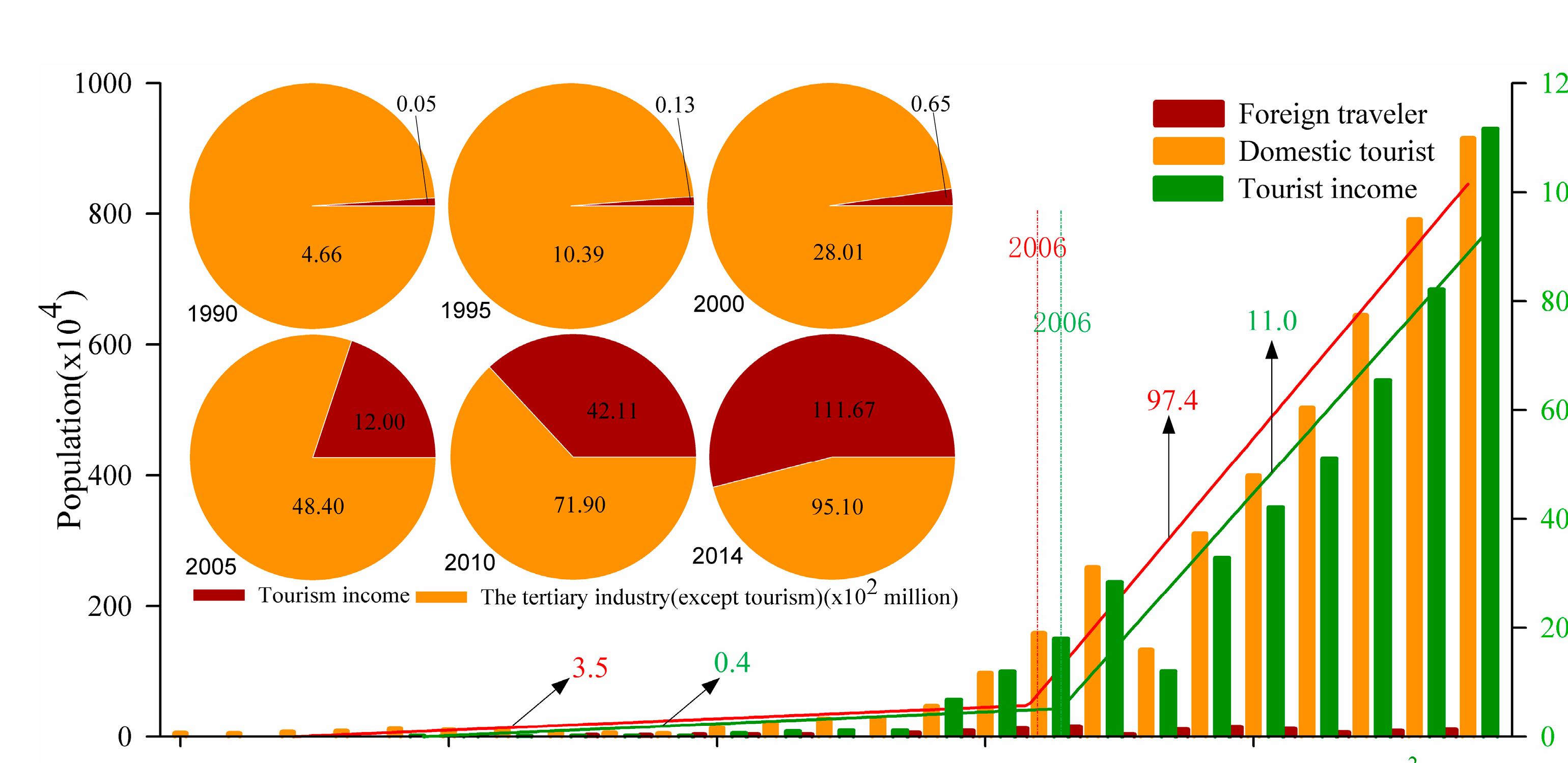

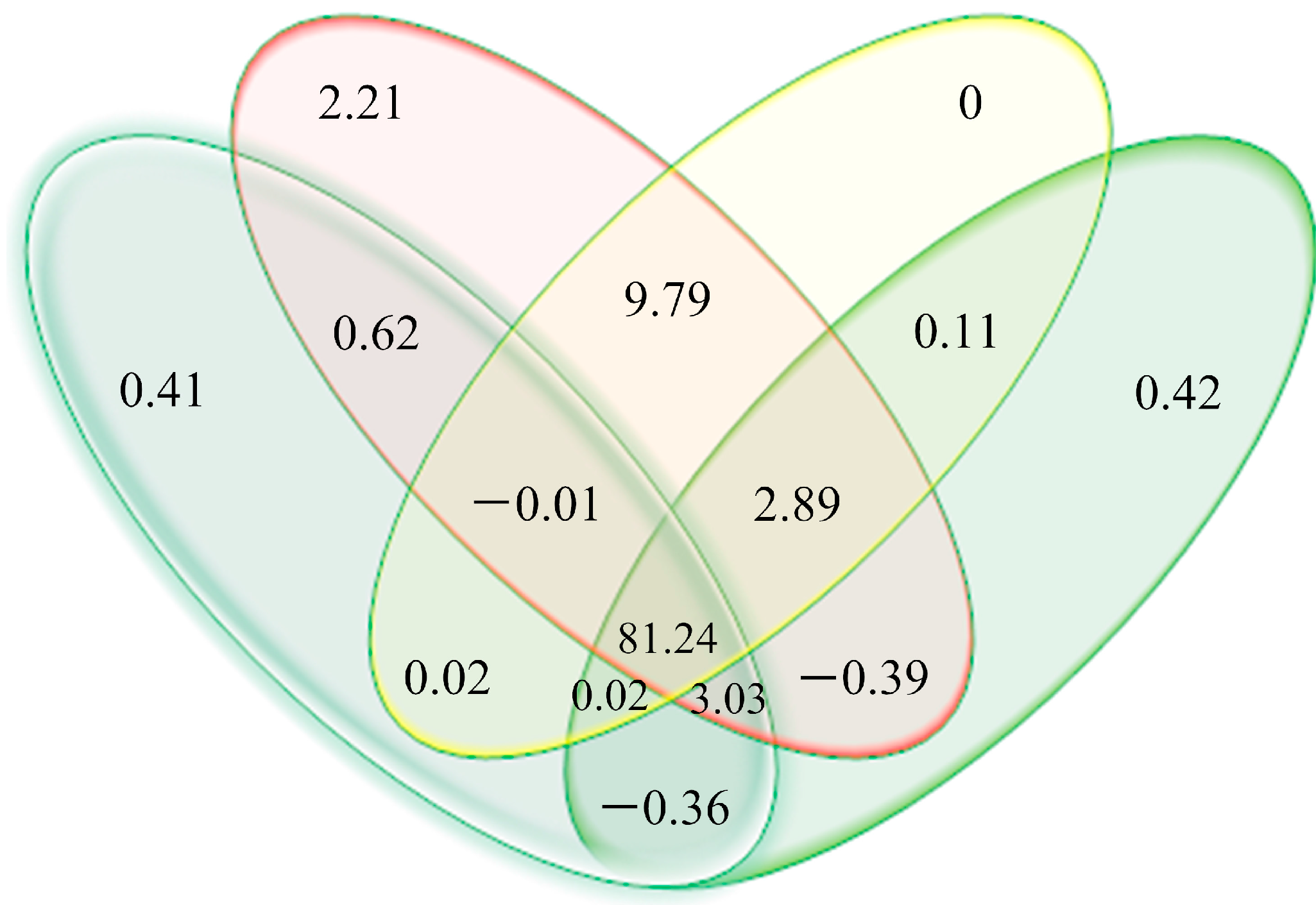
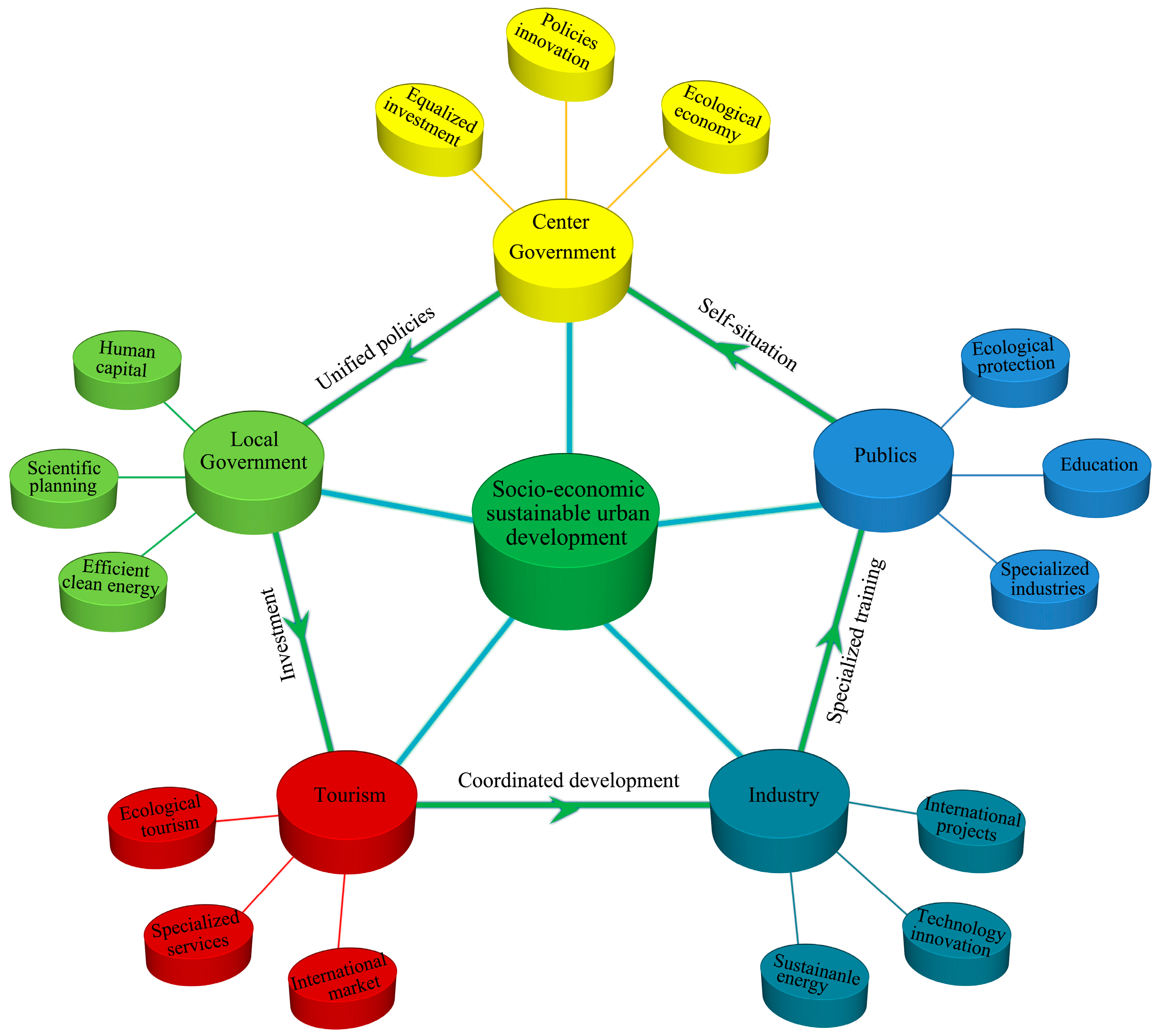
© 2017 by the authors. Licensee MDPI, Basel, Switzerland. This article is an open access article distributed under the terms and conditions of the Creative Commons Attribution (CC BY) license (http://creativecommons.org/licenses/by/4.0/).
Share and Cite
Tang, W.; Zhou, T.; Sun, J.; Li, Y.; Li, W. Accelerated Urban Expansion in Lhasa City and the Implications for Sustainable Development in a Plateau City. Sustainability 2017, 9, 1499. https://doi.org/10.3390/su9091499
Tang W, Zhou T, Sun J, Li Y, Li W. Accelerated Urban Expansion in Lhasa City and the Implications for Sustainable Development in a Plateau City. Sustainability. 2017; 9(9):1499. https://doi.org/10.3390/su9091499
Chicago/Turabian StyleTang, Wei, Tiancai Zhou, Jian Sun, Yurui Li, and Weipeng Li. 2017. "Accelerated Urban Expansion in Lhasa City and the Implications for Sustainable Development in a Plateau City" Sustainability 9, no. 9: 1499. https://doi.org/10.3390/su9091499





